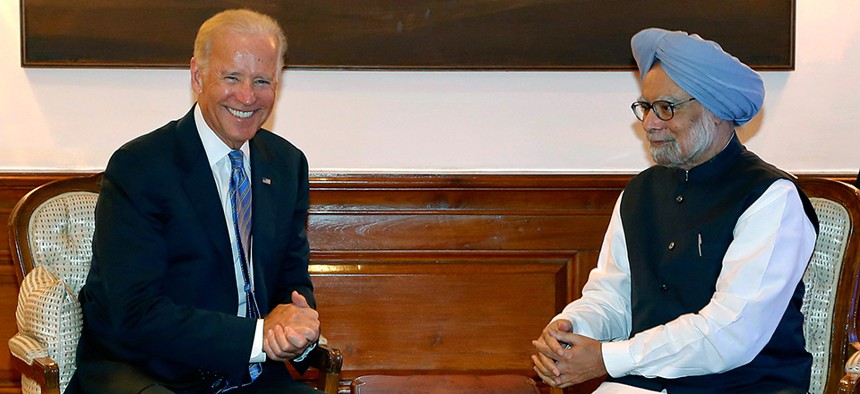
Vice President Joe Biden during his meeting with India's Prime Minister Manmohan Singh Harish Tyagi/AP
Biden’s Passage to India Should Include Afghanistan
Obama’s Afghanistan drawdown won’t work without help from the world’s largest democracy. By Kedar Pavgi
India and the United States are two ethnically diverse, robust democracies confronting similar national security challenges. Theoretically, this should be one of the Obama administration’s strongest and most reliable international partnerships. The reality is that Vice President Joe Biden’s trip to India is a repair mission to mend the chilly relationship between Washington and New Delhi, and it comes right when the U.S. could use India’s help in securing a post-war peace in nearby Afghanistan.
However, Biden’s Tuesday meetings with Prime Minister Manmohan Singh and President Pranab Mukherjee were undoubtedly shadowed by the looming security challenge created by the U.S. drawdown in Afghanistan. Whether the Obama administration pursues a “zero-option” and withdraws all troops by the end of next year or elects to maintain a small force, the U.S. will need India’s support for the post-2014 future in Afghanistan.
As the Los Angeles Times reported, Biden isn’t expected to present any “deliverables,” rather he is there to smooth over mutual distrust. Afghanistan is only part of an agenda that includes implementation of the faltering India Civil Nuclear Agreement, along with economic and trade items.
India is reluctant to ramp up its current assistance programs to Afghanistan because of concerns of a possible backlash from Pakistan and a fear of possible collateral damage (especially through terrorist attacks) if anything does go awry. Until now, India has given over $2 billion to Afghanistan, mostly in humanitarian and reconstruction aid. In May, India rebuffed Afghanistan President Hamid Karzai’s request for additional military equipment. India’s External Affairs minister Salman Khurshid later told the Straits Times that the Indian government had no plans to further expand its program and said that India didn’t “want to become part of the problem.”
So far, the U.S-India relationship has been largely “transactional,” wrote Tanvi Madan Brookings Institution fellow and director of the New India project, last month. Both sides, she argued, have conducted diplomatic negotiations expecting immediate returns, when a longer-term relationship bound by regular contact is likely necessary for the types of challenges to be faced.
The White House could begin this process by doing more to provide India additional political cover from Pakistani concerns about encirclement. Washington’s security assistance could incentivize India to lend more support for Afghanistan’s fledgling government. It’s in India’s -- and by extension the United States’ -- direct interest to ensure a stable, and prospering Afghanistan once U.S. military presence is reduced. Any future volatility, whether it’s through a resurgent Taliban or a future Afghan government that is beholden to China and Pakistan, will be adverse to India’s security interests and will become a headache for U.S. policymakers..
Giving India a bigger role will surely placate Karzai,, who’s schooling in India has been a factor in his warmness towards New Delhi, and both countries longstanding cultural ties have the grounds for a deep bilateral relationship. As thousands of American troops make the journey back stateside, India could help fill the stability vacuum – if the U.S. could get India to do more, and get Pakistan to go along with it. It’s worth the try.
The basis for an expanded U.S.-India partnership is slowly being laid, but more must be done in the coming months. In June, Secretary of State John Kerry, U.S Pacific Command chief Adm. Samuel Locklear and other top officials visited India under the auspices of the U.S.- India Strategic Dialogue. Both sides have reaffirmed the need to have a “stable, democratic, united, sovereign and prosperous Afghanistan.” More progress along those lines will be necessary in the coming months, and certainly before Singh visits Washington in September.
Biden said in his pre-trip speech last week that the administration intended to create “21st century rules of the road” in Asia and the Pacific region to help maintain global stability and economic progress. He could start by elevating India’s role in its own neighborhood.
NEXT STORY: Want Syria? Convince General Dempsey




